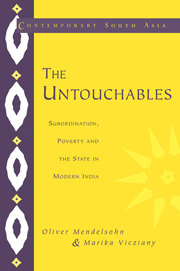Book contents
- Frontmatter
- Contents
- List of tables
- Glossary
- Preface
- 1 Who are the Untouchables?
- 2 The question of the ‘Harijan atrocity’
- 3 Religion, politics and the Untouchables from the nineteenth century to 1956
- 4 Public policy I: adverse discrimination and compensatory discrimination
- 5 Public policy II: the anti-poverty programs
- 6 The new Untouchable proletariat: a case study of the Faridabad stone quarries
- 7 Untouchable politics and Untouchable politicians since 1956
- 8 The question of reservation: the lives and careers of some Scheduled Caste MPs and MLAs
- 9 Subordination, poverty and the state in modern India
- Bibliography
- Index
6 - The new Untouchable proletariat: a case study of the Faridabad stone quarries
Published online by Cambridge University Press: 05 June 2012
- Frontmatter
- Contents
- List of tables
- Glossary
- Preface
- 1 Who are the Untouchables?
- 2 The question of the ‘Harijan atrocity’
- 3 Religion, politics and the Untouchables from the nineteenth century to 1956
- 4 Public policy I: adverse discrimination and compensatory discrimination
- 5 Public policy II: the anti-poverty programs
- 6 The new Untouchable proletariat: a case study of the Faridabad stone quarries
- 7 Untouchable politics and Untouchable politicians since 1956
- 8 The question of reservation: the lives and careers of some Scheduled Caste MPs and MLAs
- 9 Subordination, poverty and the state in modern India
- Bibliography
- Index
Summary
In recent years another figure of Indian poverty has intruded itself beside that of the familiar poor villager. This figure is one of the great and growing army of men, women and children labouring on roads, construction sites, quarries and brickworks, and living in ‘dwellings’ made of bits of scrap. These people are most numerous either within or close to the growing cities and towns of India, and they have been present from the beginnings of modern urban life during the colonial period. But the scale of the phenomenon is growing fast, and it represents a kind of distorted reflection of the urbanisation and overall economic growth which India is now undergoing. Urbanisation holds out prospects of a better life for tens of millions of people in the countryside, but for the labourers who build the towns and cities it tends to represent another version of a familiar poverty.
What could be called the new Indian proletariat, sometimes lumpen proletariat, is not always sharply distinguishable from other categories of poverty within the Indian population. But what we have in mind is people who have a history of migration from their home village, are locked into menial labour, and exist in forms of habitation that are grossly inferior to minimum human standards. This category is broad enough to encompass, for example, a considerable proportion of the great city of Bombay, some half of whose citizens are said to live either in the ‘slums’ or on the pavements. But it would be wrong to suggest that all those who perform hard labour outside their village can usefully be fitted into such a grouping.
- Type
- Chapter
- Information
- The UntouchablesSubordination, Poverty and the State in Modern India, pp. 176 - 202Publisher: Cambridge University PressPrint publication year: 1998

